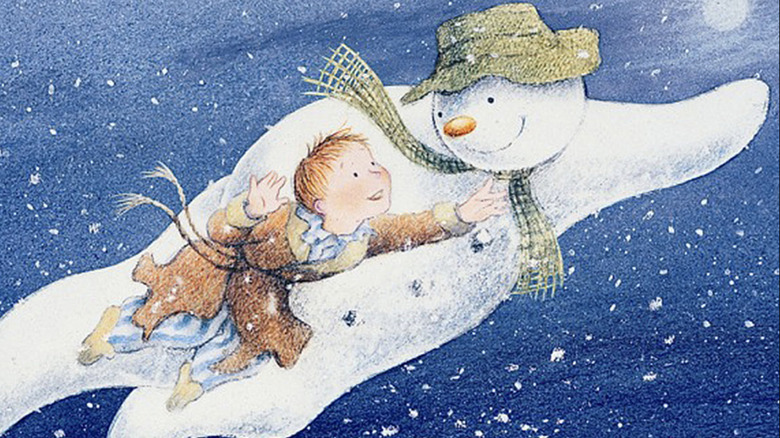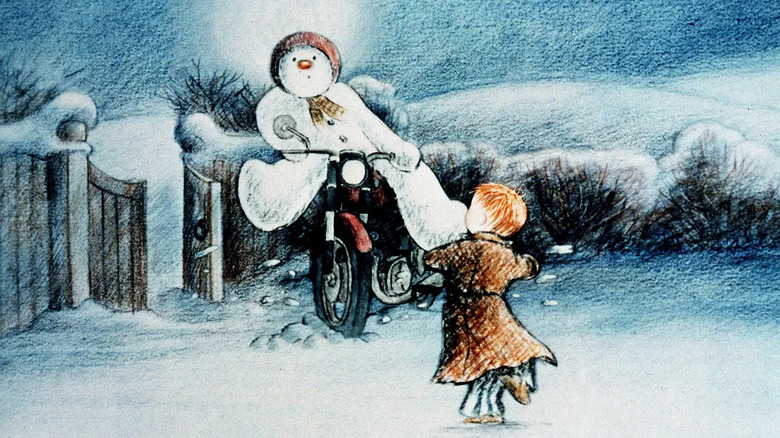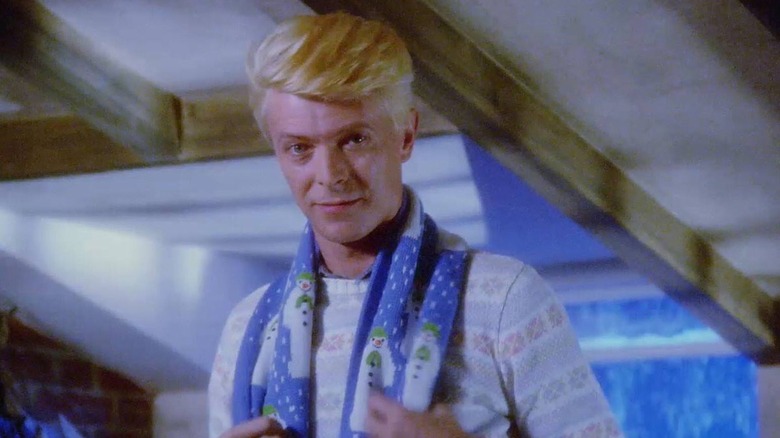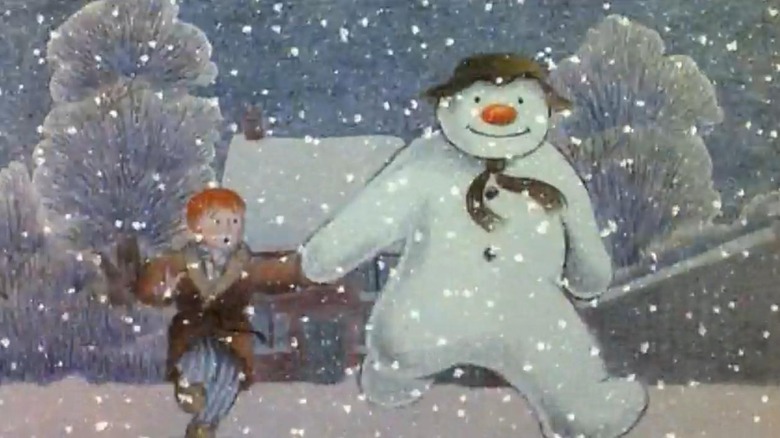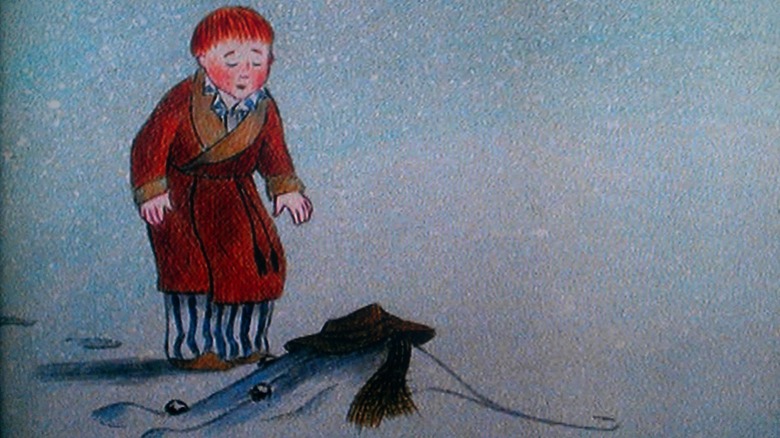Why Raymond Briggs' The Snowman Has Become A Holiday Favorite In The United Kingdom
1982 was a big year for telly addicts in the United Kingdom. After so many years of making do with just three terrestrial channels, we were finally getting a fourth that promised fresh, diverse, innovative, and challenging programming. They called it ... Channel 4. Not the most original name, granted, but it would offer a far edgier alternative to the staid Auntie Beeb (BBC1 and its artsy sister channel BBC2) and the safe light entertainment of ITV, not to mention greater variety.
After months of hype, the fledgling broadcaster lived up to its bold promise, generating plenty of headlines and predictably drawing the ire of the ever-enraged moral crusader, Mary Whitehouse. It was awesome and became my go-to channel in my teens but, as a kid, it caused me a lot more legwork switching between stations at my family's behest in the days before remote control became a regular thing.
While the new channel caused a stir with its more controversial material, it had a gentler side, too. On Boxing Day 1982, it staked its claim for a share of the holiday viewing with a premiere of "The Snowman," a beautifully animated version of the wordless children's book from Raymond Briggs. By turn twee, nostalgic, silly, wondrous, and ultimately very sad, it became an instant classic and has aired every Christmas in the UK since. I was four years old at the time so I can't say for certain whether we tuned in for that first screening, but I can tell you that it became as much a part of our family Christmases as tinsel, the Queen's speech, "The Great Escape," and turkey sandwiches for weeks on end. So what exactly makes this Oscar-nominated short so special to us Brits?
So what happens in The Snowman again?
A young boy wakes up one morning to discover there has been a heavy snowfall overnight. In delight, he throws on some clothes and runs outside to play, building a snowman in the garden. That night he sneaks downstairs to check on it while his parents are in bed and, at the stroke of midnight, the snowman magically comes to life.
After showing his new friend around the house, they take his dad's motorcycle out for a joyride through the snowy countryside. The heat from the engine melts the snowman's legs a little, so the boy helps him recover by letting him sit in the trunk freezer in the garage. All is good until the snowman spots a picture of the Arctic on a box of fish fingers, making him feel homesick. Then comes the film's highlight as he takes the boy on a spectacular flight through the night sky to Lapland, where they join many other snowmen at Father Christmas's holiday bash. The snowman whisks him home before the sun rises and they hug goodnight. When the boy rises the next day, he runs outside again to see his friend but is devastated to find that he has melted in the sun.
Director Dianne Jackson and her animation team expanded on Raymond Brigg's original tale, adding the cinematic motorcycle ride, the trip to Lapland, and a Christmas theme that also wasn't in the book. The animation is so gorgeous that I get completely absorbed in it; every frame was painstakingly hand-drawn with pastels and crayons, which gives the film a wonderfully tactile homespun feel. Personally, I can do without the shenanigans in the house and Father Christmas, but what keeps me coming back each year are three things: The introduction, the flying sequence, and the heartbreaking ending.
Raymond Briggs vs David Bowie
When "The Snowman" first aired, it was introduced by the book's famously curmudgeonly author, Raymond Briggs. We joined him trudging around a muddy field in his wellies to the sound of crows cawing in the background as he sets the scene:
"I remember that winter because it brought the heaviest snow that I had ever seen. Snow had fallen steadily all night long, and in the morning I awoke in a room filled with light and silence. The whole world seemed to be held in a dream-like stillness. It was a magical day, and was on that day that I made The Snowman."
The gentle strains of the "Walking in the Air" theme begin and the scene transitions to the soft animation of the film. It's simple, bleak, very British, and perfectly in keeping with the melancholy nature of the film.
When it came to trying to break the U.S. market, the producers felt they needed a bigger name for the introduction. They managed to snag David Bowie who had just provided the title song for another Raymond Briggs adaptation, "When the Wind Blows." His intro is a far more glossy affair, casting the "Labyrinth" star as the grown-up version of the kid in the film, wistfully talking about the snowy winters when he was a lad.
For the 20th anniversary, a new introduction was made using the same hand-drawn techniques with comedian Mel Smith voicing Father Christmas, but no one really remembers that one. I know many people prefer the starry David Bowie intro, but it is Raymond Briggs all the way for me. The scene reminds me of walks with my dad in the lanes and fields near our house when I was a kid, and the author's grumpy voice-over gives it a far more personal touch.
Walking in the Air
The undoubted highlight of "The Snowman" is the flying sequence as the boy and the snowman soar through the wintry skies. Along the way, they look down at the snow-covered landscape, encounter a whale in the icy North Sea, witness the aurora borealis, and arrive in the forests of Lapland in time for the party. It's a scene of such breathtaking beauty and where the animation is at its most evocative, really capturing the unreal hush that descends on your world when it is covered by a blanket of snow.
The scene is also where Howard Blake's elegant score also takes flight. There are strains of "Walking in the Air" earlier, but this time it includes lyrics sung with such clean purity by chorister Peter Auty, who wasn't even credited for his work at first. The song adds an ethereal quality to an already magical scene which became the defining moment of the film.
"The Snowman" and "Walking in the Air" were already synonymous with a British Christmas when Toys "R" Us opened their first UK stores in 1985. The chain commissioned a new version of the song for their TV adverts with Welsh singer Aled Jones stepping in for Auty, whose voice had broken since singing for the film. It was released as a single and the 14-year-old choir boy found himself jostling for Christmas Number One alongside the huge Band Aid single ("Do they Know It's Christmas?") and losing out to Shakin' Stevens ("Merry Christmas Everyone").
Aled Jones became a household name, to the point that many people still believe that it was his voice in the film. The producers belatedly addressed that issue when they added Auty's name to the 20th-anniversary edition, so finally, he is getting the credit he deserves.
Why the sad ending of The Snowman keeps us coming back for more
For all the charm and innocence of "The Snowman," it is ultimately a film about death. You love people and go on a great adventure with them, then they die, leaving you with nothing more than memories. Happy Christmas, everyone! Many of Raymond Briggs' most famous works had a sense of melancholy, yet the author was very matter-of-fact about this sad ending (via The Guardian):
"I create what seems natural and inevitable. The snowman melts, my parents died, animals die, flowers die. Everything does. There's nothing particularly gloomy about it. It's a fact of life."
"The Snowman" has plenty for kids to enjoy, but it also strikes a chord at a time of year when a lot of us are feeling wistful and nostalgic. So many memories are attached to those family occasions around Christmas time and the film grows in poignancy as loved ones pass away over the years. I was a little boy when it first came out and most of my grandparents are no longer with us; now I have kids of my own and the cycle continues as we pass this cherished classic down as part of our Christmas tradition.
Despite our reputation for stiff upper lips, we Brits can be a maudlin bunch at times. This downbeat conclusion may be what brings us back to it year after year, for a nice kick in the feels after all the presents have been opened and we munch on our umpteenth mince pie.
Lovely grumpy old Raymond Briggs passed away earlier this year aged 88, which will add an extra level of sadness to this year's screening as "The Snowman" celebrates its 40th anniversary. The enduring popularity of his most well-known work will ensure he is not forgotten.
